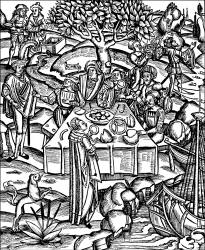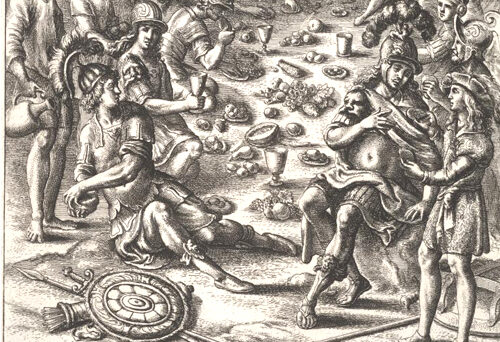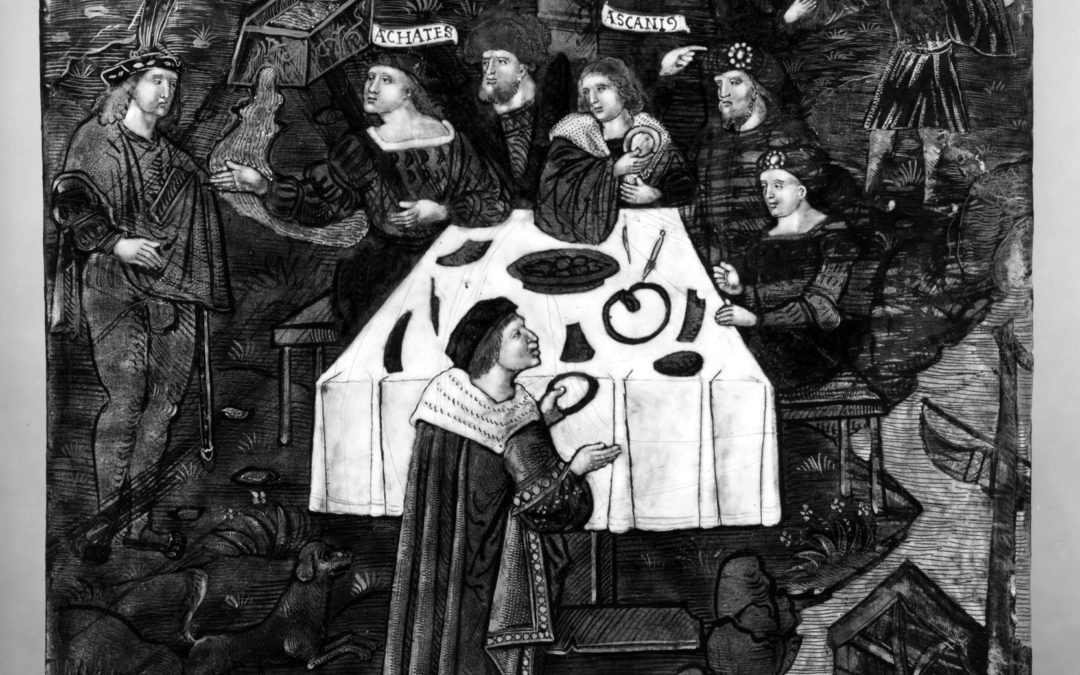A prophecy held that Aeneas and companions would know where to build the new Troy when being desperately hungry, they ate their plates—trenchers made of thick slices of stale bread. This revelation occurs at their first meal in Latium.

Sebastian Brant. Works of Virgil [Publius Vergilius Maronis Opera]. Strasbourg: Johann Grüninger 1502. The engraver is unknown.
Beneath a shady tree, the hero spread
His table on the turf, with cakes of bread;
And, with his chiefs, on forest fruits he fed.
They sate; and, (not without the god’s command,)
Their homely fare dispatch’d, the hungry band
Invade their trenchers next, and soon devour,
To mend the scanty meal, their cakes of flour.
Various visual interpretations have interpreted the scene differently. For instance, the 1502 illustration for Sebastian Brant’s Works of Virgil [Publius Vergilius Maronis Opera] is literal and shows the Trojans dining at a table in the shade of a tree. Except that this is alfresco, they might as well be eating indoors. Wenceslaus Hollar interprets the scene as a repas de chasse, and like hunters gathering for a meal in the field, he presumes the Trojans set their table on a carpet on the grass. They feast, but there is no evidence of desperate hunger. Probably influenced by Hollar, George Christoph Eimmart’s illustration suggests a leisurely meal among friends rather than battle-hardened soldiers in the field.

Wenceslaus Hollar. Detail. The Trojans’ First Meal in Latium (1654), etching after Francis Cleyn. In Virgil’s Work, translation by John Ogilvy. London, 1654. The University of Toronto Hollar Digital Library
Featured Image: Master of the Aeneid Legend. Fulfillment of the Prophecy of Anchises (1530/40). Painted enamel on silvered copper. Baltimore: Walters Art Museum; This is based on Brant’s illustration; http://art.thewalters.org/detail/15337/the-fulfillment-of-the-prophecy-of-anchises/
See Sebastian Brant. Works of Virgil [Publius Vergilius Maronis Opera]. Strasbourg: Johann Grüninger 1502; http://spiritoftheages.com/Vergil%20-%20”Opera”%20(1502).htm; Virgil. The Aeneid, Translated by John Dryden. London: Richard Pennington. A Descriptive Catalogue of the Etched Work of Wenceslaus Hollar 1607-1677.Cambridge: Cambridge University Press, 1982; Katherine S. Van Eerde. Wenceslaus Hollar: Delineator of His Time. Washington, D.C., Folger Shakespeare Library, 1970; George Gascoigne. London: Imprinted by Henry Bynneman for Christopher Barker, 1575.

